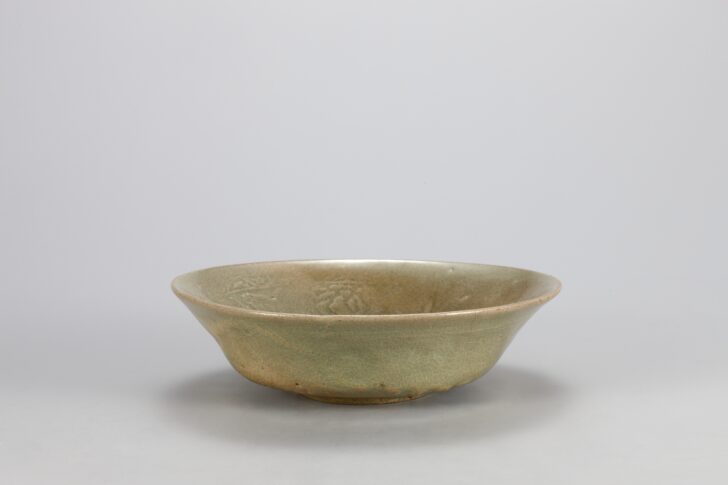Shallow flat-bottomed bowl with molded floral designs
Korean

Description
Subject Matter:
Initially, Goryeo potters learned much of the technical expertise from the celadon traditions of Song-dynasty (960–1279) China, particularly of its southern coast. A Song envoy, Xu Jing (1091–1153), who visited the Goryeo capital, Gaeseong, in 1123, noted the resemblance of Goryeo ceramics to the celadons of China's Yue and Ru kilns. We see in early Goryeo examples a conscious emulation of certain stylistic features of Chinese wares—such as the shapes of bottles and bowls, and standard decorative motifs including lotuses, peonies, flying parrots, and scenes of waterfowl by the pond.
By the mid-twelfth century, Goryeo potters and patrons turned to articulating native tastes. This coincided with the consolidation of major celadon industries near the southwestern coast of the peninsula, in Jeolla Province—the Buan and Gangjin regions especially. The latter remains, today, the center of modern celadon production and of revivals of Goryeo traditions. The culmination of Goryeo celadon can be seen in inlaid (sanggam) celadon, a rarity in China. The delicate technique of sanggam involves etching the desired motifs on the dry clay body and filling in the carved space with black and/or white slip, after which the translucent glaze is applied and the vessel fired. The best of Goryeo inlaid celadon is breathtaking in its splendid presentation of clean form, vibrant design, and subtle yet alluring color combination of white, black, and green.
Physical Description:
The inner base and walls of this celadon dish are mold-impressed with a peony and peony scrolls, respectively. The low foot retains traces of quartzite supports in three places. The glaze is poorly fused, showing traces of its running, while partial oxidization has given the dish a yellow-green hue in parts.
[Korean Collection, University of Michigan Museum of Art (2014) p.114]
Usage Rights:
If you are interested in using an image for a publication, please visit https://umma.umich.edu/request-image/ for more information and to fill out the online Image Rights and Reproductions Request Form.